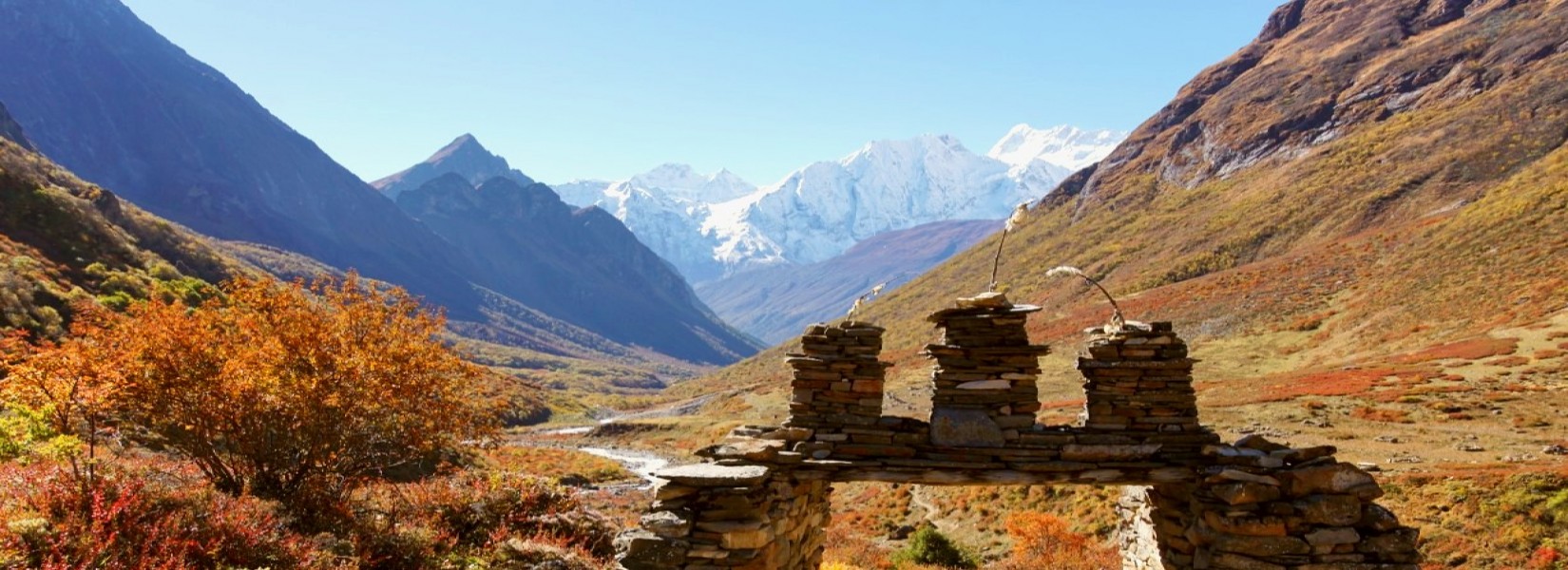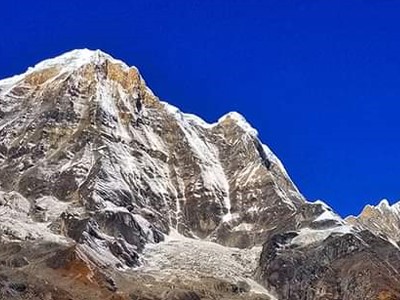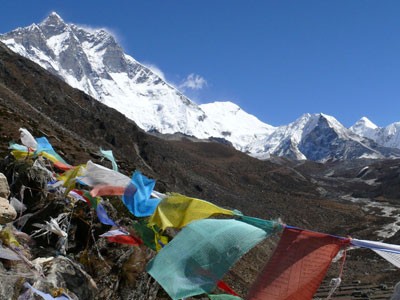The Manaslu Circuit Trek offers a captivating journey through diverse landscapes and rich cultural experiences. Known as the off-the-beaten-path trek in Nepal, the Manaslu Circuit Trek takes about 12-16 Days to complete. We offer 16 Days Manaslu Circuit Trek in Nepal Spirit Adventure.
Similarly,solo trekking on the Manaslu Circuit trail is not available as it is a restricted area. Before trekking in this beautiful trekking area, there are lots of things that you need to learn. Thus, in this blog, we will cover the Manaslu Circuit Trek Best time.
Manaslu Circuit Trek Routes & Terrain
The terrain along the Manaslu Circuit Trek is diverse, ranging from lush forests and terraced fields in the lower altitudes to alpine meadows and rocky trails at higher elevations.
Trekkers can expect to encounter suspension bridges, river crossings, and steep ascents, all contributing to the adventurous nature of this trek. Here is an outline of what the Manaslu Circuit Trek Itinerary looks like:
- Day 2: Obtain Manaslu trek permit overnight in Kathmandu
- Day 3: Bus drive to Machha Khola (9,00m/2,920ft) 7-8 hours journey
- Day 4: Trek from Machha Khola to Jagat (1370m) 6 - 7 hours
- Day 5: Trek from Jagat to Deng (1,860m/6,102ft) 6 - 7 hours
- Day 6: Trek from Deng to Namrung (2630m/8626ft) 6 - 7 hours
- Day 7: Trek from Namrung to Samagaon (3,530m/11,581ft) 6 - 7 hours
- Day 8: Acclimatization in Samagaon, optional day hike
- Day 9: Trek from Samagaon to Samdo (3,860m/12,660ft) 4-5 hours
- Day 10: Trek from Samdo to Dharmshala (4,460m/14,632ft) 4 - 5 hours
- Day 11: Trek from Dharamsala to Bimthang (3590m) via Larkya La Pass (5,215m/17,109ft) 8 - 9 hours
- Day 12: Trek from Bimthang to Tilije (2,300 m/7,546ft) 5 - 6 hours
- Day 13: Trek from Tilije to Tal (1,700m/5,577ft) 5-6 hours
- Day 14: Trek from Tal to Syange (1,080m/3,542ft) 5-6 hours
- Day 15: Drive from Syange to Kathmandu 7- 8 hours bus
Besides that, do you know how weather or seasons can affect the trekking trail?
During the spring season, the terrain along the Manaslu Circuit Trek undergoes a vibrant transformation. While the monsoon season brings a noticeable shift in terrain conditions.
Autumn offers some of the most stable and enjoyable terrain conditions for the Manaslu Circuit Trek. And, Winter transforms the terrain along the Manaslu Circuit Trek into a snow-covered wonderland, particularly at higher elevations.
To make it more clear and understandable, here are the seasons and months that you may find the best time for Manaslu Circuit Trek.
Manaslu Circuit Trek during Spring Season
Spring Season is considered one of the best trekking seasons in Nepal and also the best time for the Manaslu Circuit trek. The lower altitudes feature lush forests and blooming rhododendrons, creating a picturesque setting.
As trekkers ascend, they'll encounter well-maintained trails with occasional rocky sections. The terrain is generally stable and dry, making for comfortable trekking conditions.
However, due to climate change and other factors, the early season is slightly unstable in terms of weather. So, here are the details of the Spring season in terms of month to make it easy for you to choose your best time.
Manaslu Trail during March:
March is the starting season for trekking destinations like Manaslu Circuit Trek.
In March, the weather along the Manaslu Trek starts to gradually warm up. At lower altitudes, such as in Arughat (600m) and Soti Khola (800m), daytime temperatures can range from 15°C to 20°C, providing comfortable trekking conditions.
As you ascend to higher elevations, especially in places like Lho (3,100m) and Samagaon (3,500m), the temperatures can drop significantly, especially during the night.
However, the possibility of encountering snowfall, foggy trails,s, and icy trails is expected during early March. So, pack essential gear for cold weather during the March period.
Manaslu Trail during April:
April is a splendid time to embark on the Manaslu Trek, as it heralds the arrival of spring in the Himalayan region. April marks the transition to clearer and more stable trails along the Manaslu Trek.
While some remnants of snow may still be present at higher elevations, they are typically limited to shaded areas. Rhododendrons, the national flower of Nepal, burst into vibrant blooms, painting the landscape with shades of red, pink, and white.
At lower altitudes, such as in Arughat (600m) and Soti Khola (800m), daytime temperatures range from 25°C to 30°C (77°F to 86°F). As you ascend to higher elevations, temperatures may drop to around 5°C to 10°C.
Manaslu Trail during May:
During May, the Manaslu region experiences warmer temperatures, especially at lower altitudes. In places like Arughat (600m) and Soti Khola (800m), daytime temperatures range from 30°C to 35°C (86°F to 95°F).
As you ascend to higher elevations, the temperatures remain pleasantly warm during the day, Nighttime temperatures may hover around 10°C to 15°C.
In May, the trails along the Manaslu Trek are at their best. The terrain is well-defined and relatively dry, making for smooth and enjoyable trekking.
Advantages of Trekking in the Spring Season:
Trekking in the Spring Season, which encompasses the months of March to May, offers a multitude of advantages:
Flourishing Flora and Fauna: March sees fewer trekkers compared to peak seasons, allowing for a more peaceful and intimate experience with the natural surroundings. The hillsides burst into a riot of colors with blooming rhododendrons, magnolias, and various other wildflowers.
Moderate Weather: The temperatures in March strike a balance between the remnants of winter and the forthcoming warmth of spring, creating comfortable trekking conditions.
Clear Views: The skies are generally clear, offering unobstructed views of the majestic Himalayan peaks. This is particularly rewarding for trekkers, as they can fully appreciate the awe-inspiring beauty of the Himalayan range.
Cultural Experience: Interact with local communities along the trail, experiencing their way of life and cultural practices.
Manaslu Circuit Trek during Autumn Season
Autumn, spanning from September to November, is arguably the most sought-after season for embarking on the Manaslu Circuit Trek.
This time of year offers a perfect blend of favorable weather conditions, clear skies, and breathtaking scenery, making it a prime window for trekking enthusiasts.
Manaslu Trek During Septermber:
September marks the onset of autumn in the Manaslu region. While the monsoon season is waning, there might still be occasional rainfall, especially in the early part of the month.
At lower altitudes (around 800m to 2000m), daytime temperatures range from 20°C to 25°C (68°F to 77°F), offering comfortable trekking conditions.
At higher elevations (above 3000m), daytime temperatures can drop to around 10°C to 15°C (50°F to 59°F), particularly in the latter part of the month.
September is a less crowded month compared to peak trekking season (October and November). Tea houses and lodges along the trail are open and well-prepared to receive trekkers. You'll find a range of accommodation options, though it's advisable to book in advance, especially in more popular stops.
Manaslu Trek In October
Trekking the Manaslu Circuit in October is a splendid choice, as the region transitions into its peak trekking season. October heralds the arrival of autumn, bringing stable weather conditions to the Manaslu region.
At lower altitudes (around 800m to 2000m), daytime temperatures range from a comfortable 20°C to 25°C (68°F to 77°F). At higher elevations (above 3000m), daytime temperatures can range from 10°C to 15°C. with nighttime temperatures dropping further to about 0°C to 5°C (32°F to 41°F).
Expect to encounter a moderate level of fellow trekkers, especially around popular spots and lodges. Accommodation options are plentiful, though it's still recommended to make reservations in advance, especially in busier areas.
Manaslu Trek During November:
Trekking the Manaslu Circuit in November offers a unique and captivating experience as the region transitions from autumn to winter. November marks the end of the autumn season in the Manaslu region. Days are crisp and clear, while nights begin to get colder.
At lower altitudes (around 800m to 2000m), daytime temperatures range from 15°C to 20°C (59°F to 68°F). The landscape undergoes a transformation as the autumn leaves start to fall, revealing the rugged terrain and offering unobstructed views of the mountains.
In early November, higher passes like the Larkya La may have traces of snow or frost in shaded areas.
Advantages of Trekking in the Autumn Season:
Trekking in the autumn season, which spans from September to November, is a highly favored time for venturing into the mountainous terrains, and for good reasons.
Ideal Weather Conditions: Days are characterized by clear skies, providing unobstructed views of the stunning landscapes and majestic peaks.
Minimal Precipitation: Rainfall is significantly reduced compared to the monsoon season. This means that trails are less slippery and prone to landslides, offering safer and more enjoyable trekking conditions.
Cultural Festivals: This season coincides with various cultural festivals in Nepal, including Dashain and Tihar. Witnessing and partaking in these celebrations provides a deeper cultural immersion and a chance to connect with local traditions.
Stable Weather Patterns:
Unlike the spring season, where temperatures can be more unpredictable, autumn offers a stable weather pattern, reducing the likelihood of unexpected weather-related challenges.
Manaslu Trekking Condition During Monsoon & Winter Season
Monsoon Season & Trekking Conditions:
Monsoon season in Nepal, which spans from June to August, brings heavy rainfall to the region. The trails can be muddy and slippery due to the continuous rain. From June to August, trekking during the early month of June period is possible but it comes with certain considerations.
Trekkers should be aware of the potential challenges posed by the monsoon season, including rain, landslides, and slippery trails.
What are the risks of doing a trek in the monsoon season?
The monsoon season brings heavy and prolonged rainfall to the region. This can lead to swollen rivers, landslides, and slippery trails, making certain sections of the trek potentially dangerous.
Similarly, in some remote areas, tea houses may close during the monsoon season due to reduced trekker traffic.
How do you prepare for trekking in monsoon?
Trekking in the monsoon season offers a unique experience amidst lush landscapes, but it comes with its own set of challenges. Pre-June and post-August can be suitable for trekking. Here are some essential tips for preparing for a monsoon trek:
- Invest in high-quality waterproof gear, including rain jackets, pants, and covers for your backpack.
- Pack lightweight, quick-drying clothing made of moisture-wicking materials.
- Use waterproof covers or liners to protect your gear from rain.
- Bring waterproof cases or covers for electronic devices like cameras, smartphones, and GPS devices.
- Bring a few extra plastic bags to store wet clothes or items, keeping them separate from dry ones. Use a recycle bin to dispose of the plastic bags.
- Include basic medical supplies like bandages, antiseptics, pain relievers, and any personal medications you may need.
- Seek recommendations from experienced guides or locals along the trail.
Winter Season & Trekking Condition
Trekking during the winter season in Manaslu Circuit trek is an impossible task and should not be done. However, it is still possible during the winter season with proper planning, consideration, and help from local agencies.
The suitable month for trekking the Manaslu Circuit during the winter season is early December. In December, you can expect cold nights, but the days are relatively more moderate, providing a comfortable trekking experience.
What are the risks of doing a Manaslu Circuit trek in the winter season?
Winter temperatures in high-altitude areas can drop significantly, especially during the night. Snow and ice can cover the trails, making them slippery and potentially hazardous. Similarly, winter days are shorter, which means less daylight for trekking
How do you prepare for trekking in the winter season?
As I said, the only suitable month is early December and the end of February. Preparing for trekking at these months requires careful planning and ensuring you have the right gear and knowledge. Here's a guide to help you prepare:
- Layering is key. Start with a moisture-wicking base layer, add insulating layers, and finish with a waterproof and insulated outer layer.
- Invest in sturdy, waterproof boots with good traction.
- Carry items like crampons, and trekking poles to navigate icy and snowy terrain.
- High-energy, easily prepared foods are essential. Carry a reliable stove and fuel, as well as an insulated water bottle to prevent freezing.
- Include items like a first aid kit, emergency shelter, whistle, headlamp, and fire-starting tools.
- Share your itinerary and an expected return date with someone reliable. Establish check-in times and locations.
Importance of Choosing Manaslu Circuit Trek Best Time
Now, you may have already found your best time and month for the Manaslu Circuit Trek. Choosing the best time for the Manaslu Circuit Trek is of paramount importance for a safe and enjoyable journey.
Picking the right season means clear skies, manageable temperatures, easy access to accommodation & sustainable trekking experience.
Similarly, planning the trek during the best time provides opportunities to engage with local communities, witness festivals, and experience the rich cultural heritage of the region.
In summary, it allows trekkers to fully appreciate the natural, cultural, and scenic wonders of this incredible region in Nepal.
What can be the ideal packing list for the Manaslu trek?
Here is the list of the ideal packing lists for Manaslu Circuit Trek in the Best time:
Clothing:
- Lightweight, moisture-wicking base layers (tops and bottoms)
- Insulating layers (fleece jackets, down vests, or jackets)
- Waterproof and windproof outer shell jacket and pants
- Long-sleeved shirts for sun protection
- Quick-drying trekking pants and shorts
- Thermal underwear for colder months (winter trekking)
- Trekking socks (wool or synthetic)
- Underwear (moisture-wicking and breathable)
Footwear:
- Sturdy and comfortable trekking boots with ankle support
- Trekking sandals or comfortable camp shoes
- Gaiters (optional, for snow or wet conditions)
Headwear:
- Wide-brimmed hat or cap for sun protection
- Warm beanie or hat for colder days
- Sunglasses with UV protection
- Buff or neck gaiter
Handwear:
- Lightweight gloves for sun protection
- Insulated gloves or mittens for colder days
Trekking Gear:
- Backpack (40-50 liters) with a rain cover
- Trekking poles for stability and support
- Sleeping bag suitable for the season and rated for low temperatures
- Sleeping bag liner (optional for added warmth and hygiene)
- Headlamp or flashlight with extra batteries
- Duct tape and repair kit for minor gear fixes
Personal Items:
- Sunscreen (high SPF), lip balm, and moisturizer
- Personal hygiene kit (toothbrush, toothpaste, biodegradable soap, etc.)
- Quick-drying towel
- Wet wipes and hand sanitizer
- Personal medications and basic first aid supplies
- Insect repellent and anti-itch cream
- Water purification method (tablets, filter, or UV pen)
Accessories:
- Reusable water bottles or hydration system (2 liters capacity)
- Trekking duffel bag or waterproof liner for porters (if not carrying your own load)
- Money, ID, and important documents in a waterproof pouch
- Trekking map and guidebook (if not using a guide)
Optional:
- Camera and extra batteries
- Portable solar charger or power bank
- Journal and pen
- Lightweight binoculars for birdwatching and scenic views
Snacks and Nutrition:
- Energy bars, nuts, dried fruits, and snacks
- Rehydration salts or electrolyte tablets
- Tea bags or instant coffee (if you have specific preferences)
Miscellaneous:
- Trash bags (for waste management)
- Multi-tool or Swiss Army knife
- Ziplock bags (for organizing and waterproofing items)
- Whistle and small mirror (for emergencies)
FAQ
What are the dangers of the Manaslu Circuit Trek?
The dangers of Manaslu Circuit Trek are:
- Altitude Sickness
- Harsh Weather Conditions
- Avalanches and Landslides
- Remote and Limited Medical Facilities
- Wildlife and Insects
- Restricted Area Regulations &
- Lack of Communication
How hard is it to complete the Manaslu Circuit 16 days?
Completing the Manaslu Circuit Trek in 16 days provides a more reasonable and comfortable pace compared to attempting it in a shorter duration. This extended itinerary allows trekkers to:
- Acclimatize Adequately
- Enjoy the Scenery
- Explore Local Culture
- Avoid Overexertion
- Accommodate Unforeseen Circumstances
- Manage Permits and Logistics
- Experience a Safer Trek
In conclusion, choosing the best time for the Manaslu Circuit Trek is a crucial decision that significantly impacts the overall experience. Each season has its own allure, ensuring that adventurers can find the perfect time to embark on this remarkable journey.
However, the best time is not only the factor that you should rely on as there are other important factors like Manaslu preparation, fitness, itinerary, budgeting, etc. to ensure the best experience in Manaslu Circuit Trek.




